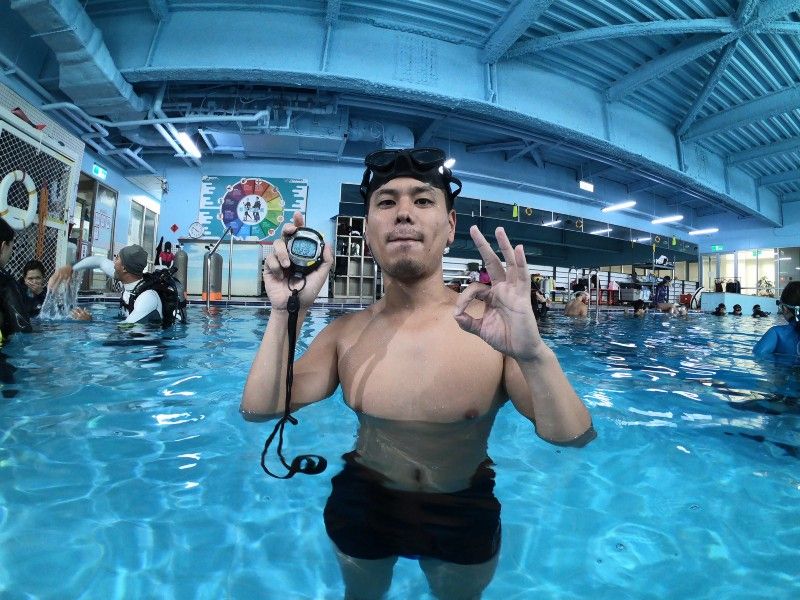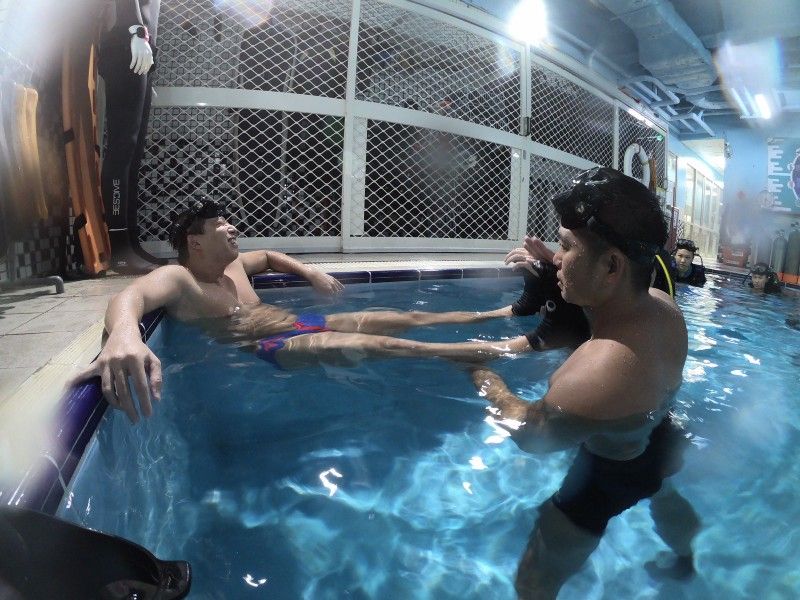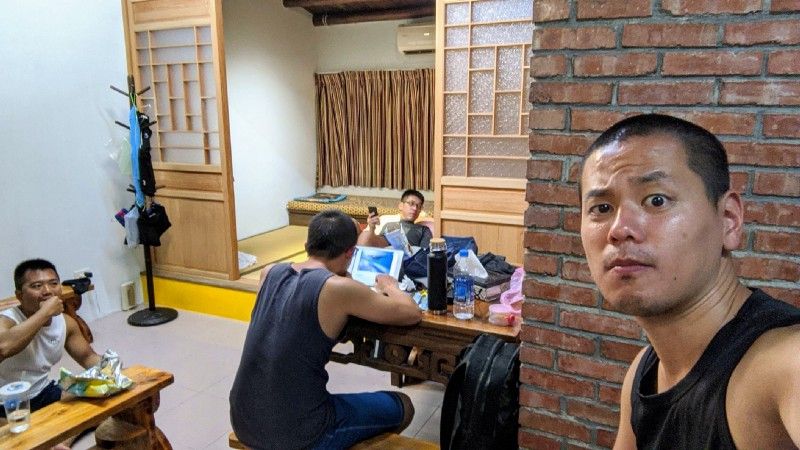Day 1 Subject and Pool Course | AIDA 2 Self-Dive Course Experience

Because I went to Okinawa to experience diving before, I was amazed at the beauty of the underwater world. After I came back, I wanted to learn diving. I just heard that they were going to learn free diving when I was chatting with a friend. I checked the free diving online. After the difference between diving and scuba diving, I decided to bite the bullet and follow.
Although I usually swim, I have no experience in water sports in open water except for snorkeling on Nagaru Island in Okinawa , so I actually had a lot of questions and anxiety before the class, and I also benefited from many online sharing of the class. Experienced people, so I hope that I can also organize the experience of the courses in the past few days and become part of the many materials that may help others.
The experience of free diving is highly private. Your own experience may not necessarily be applied to others, and the feelings of others may not be helpful to you, but multiple references can still reduce your fear of the unknown. The following words will be used a lot, such as "I think", everyone should use it as a reference.
Subject Lessons: The First Steps to Overcoming Fear
The registered course lasts for three days, and the first day is subject class plus swimming pool class.
Before the course starts, the coach will give us the traditional Chinese textbook for the course, which is about a hundred pages in total, which is really a lot. I read it myself before the course started, and felt that the whole course would be relatively advanced, I knew what each course stage was doing, and the teaching materials were very detailed.
I think the most important part of the subject class is to provide knowledge that can help you overcome your fears , which is actually very useful in the pool class and the two-day ocean class after that. For example, the core of free diving is breath-holding. The textbook actually explains the operation process very clearly. After reading the textbook, I started to practice relaxation, full breathing and breath-holding at home, and experienced diaphragm twitching. If I hadn't read the instructions in the textbook, I would have felt like I was going to die in about a minute, and I wouldn't have thought about the blood oxygen level.
But if you really don’t want to read it all, it is strongly recommended to read the parts of the respiratory cycle and respiratory physiology, and then practice holding your breath at your own home to get used to the discomfort, which will be very helpful for the entire course.
Pool Lessons: Preliminary Practice of Knowledge
In the pool class after the subject class, practical exercises will begin, including static apnea, fin kicking, dynamic flat diving, and ear pressure equalization may also be required. The pool class is really serious (at every stage), because this is the only time when you can practice fin kicking with peace of mind. After going out to sea, in addition to adapting to the fear of open water, you have to learn new things It will be very exhausting to memorize some complicated steps, and it will be too late to practice seriously.
static apnea
The static apnea that is the core of freediving, the passing requirement for AIDA 2 is two minutes. This should be one of the few items that can be practiced before the class starts.

I tried it myself in bed, and the diaphragm would start to twitch uncontrollably within at least two minutes at the latest. When I first experienced twitching, I was very scared and immediately stopped holding my breath, because the diaphragm drives the whole body. There was a lot of jitter, but then I would start counting my diaphragm twitches to divert my attention. Everyone's twitch time is not exactly the same as the situation. In my own situation, as long as I can get used to this feeling a little, I can hold my breath for two minutes on land.
Before starting the class, it is strongly recommended that everyone try static apnea on land at home. It does not mean that it must be closed for how long, but because we usually don’t have the need to hold the breath, so we understand that “it turns out that the breath is closed. After the feeling of "this is what it feels like" and "the feeling of the diaphragm twitching is like this", it can definitely reduce the psychological fear and prolong the breath-holding time.
Because of the relationship of diving reflex, when other conditions remain unchanged, it will be easier to hold your breath in water than on land.
fins
While not a program, this thing will haunt you once the pool class starts. However, apart from the fact that I found that the standing swimming posture needs to be improved in the sea rescue practice during the ocean class later, I have not been stuck on the kicking method of long fins for a long time, and there are not many suggestions that I can give.
You can try standing on land and kicking forward/backward with one foot. Because the thigh is driven, the calf and ankle will naturally swing. Then imagine that you now have an extra bone in the front of your foot, so you need to Transfer that swipe feeling to your fins. The coach will say that you need to kick with the whole foot, but this does not mean that your feet must not be bent. When you walk, your knees must be slightly bent. It can be imagined that you are walking with an extra joint (right).

Dynamic level dive
Dynamic level diving is to swim back and forth horizontally at a distance from the surface of the swimming pool. The AIDA standard is 40 meters.
This item is a comprehensive version of the first two items. You need to be able to tolerate the discomfort of holding your breath to a certain extent, and your fins can't kick at the same time. As long as the fins don't kick, they should be able to stay in the water, and the rest is to endure the problem of apnea, but because of the fins, I really can't give too much advice, so let's talk about the apnea condition of dynamic flat diving.
Because it is dynamic, oxygen consumption and carbon dioxide production will definitely be faster than breathing, so the feeling of "wanting to breathe" will be felt earlier and stronger, and I will have it about halfway through swimming. At this point, I will convince myself that as long as the diaphragm has not started pumping, it does not mean that I need to surface immediately, and I will actually finish kicking while maintaining this idea.
I don't think I have to kick very fast. The key is to relax and kick the fins.
That's about it for the first day.
I used to balance my ear pressure without using my hands when I was on a plane, so I tried it a bit during the dynamic level dive in the swimming pool class. no. So I was very nervous at the end of the ocean class the next day. It was not enough to climb the rope and dive for two or three meters. So I started to check the information before going to bed at the B&B to see what Franz should do. Fortunately, I realized it before going to bed. The next day, I went down 12 meters to see the lead block (although I still failed to pass the test).

Because the ocean course in the next two days will be in the northeast corner, the four of us decided to find a B&B nearby to stay. I think this approach is not bad. After all, it takes about an hour to come from Taipei in the morning. For the 8:00 class, you can estimate what time you need to get up. You can save transportation time by having breakfast earlier and getting up later, which is less rushed. Going to a marine class is very helpful for the first time to go to sea.
In addition to sharing and receiving experience, it can also reduce the hesitation of learning new things.
Like my work? Don't forget to support and clap, let me know that you are with me on the road of creation. Keep this enthusiasm together!

- Author
- More